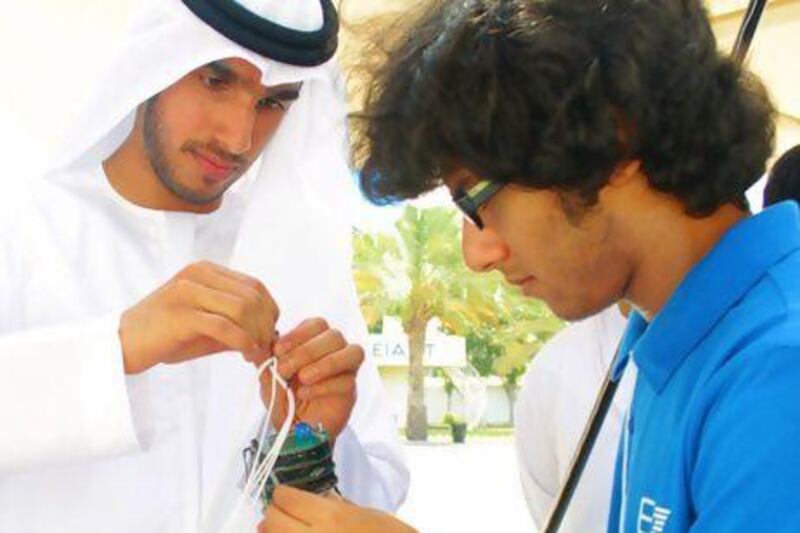DUBAI // The next generation of space engineers are having a taste of the challenges they will face thanks to a new initiative by the team behind Dubai's satellite programme.
The scheme involves the use of CanSats - devices small enough to fit inside a soft-drink can that carry scaled-down versions of the technology used on satellites that orbit the Earth.
Members of the all-Emirati team at the Emirates Institution for Advanced Science and Technology (Eiast) are giving high school pupils hands-on experience of operating the mini-satellites.
They hope this will act as an investment in the future of scientific research by encouraging more youngsters to follow in their footsteps.
"We feel there is a huge need for science, technology, engineering and maths graduates in the UAE," said the project manager, Ibrahim Al Qasimi.
"We are hoping this will convince the next generation to look at these technical fields."
Pupils from grades 9 to 11 have taken part in two pilot sessions at Eiast's headquarters in Al Khawaneej. Twenty-five boys from Omar bin Al Khattab Model School attended the first session, with 30 pupils from Al Sufouh Girls' School at the second.
The CanSats were lifted 150 metres into the air suspended from weather balloons. They were then released on a parachute and, as they drifted downwards, they transmitted data and images to a laptop ground station.
"The idea of CanSat is to simplify what we do here at Eiast and simulate an actual satellite mission," Mr Al Qasimi said. "We had the students operate the CanSats to show them what to expect after they graduate.
"The students looked at the data that came from the CanSats, which includes temperature, humidity, pressure, altitude and GPS locations.
"They tried to make sense of it and work out why the information was changing throughout the experiment."
A CanSat is divided into a number of layers, known as ports, each of which contains a particular piece of equipment.
Khalid Al Suwaidi, an assistant researcher, said: "The first port has a mechanism to release the CanSat from the balloon and release the parachute.
"The next port has the GPS and the third has the on-board computer, the CPU set which is the mastermind for the whole CanSat.
"There is a power system which regulates the flow of electricity, and the next port calculates the internal and external temperatures, the humidity and the pressure."
The other ports contain a transmitter connected to an antenna and a camera.
Hessa Al Matroushi, an assistant researcher, said: "I sat with the students and explained how the ground station operates. There is an antenna attached to the computer so we can gather the date from the CanSat while it is up in the air.
"We have software which displays the information - we can monitor the temperature, the humidity and the pressure and we can even see the altitude and the orientation of the CanSat."
Some of the images from the CanSat were unclear because interference disrupted the signal.
"We showed that to the students and explained to them what is happening and why the images were not received well, and how to rectify it," Ms Al Matroushi said.
"I am from the image-processing department and that is what we do in reality."
Mr Al Qasimi said the pilot sessions were intended to assess the level of the pupils and that a much larger event involving more schools would be held in the winter.
The use of balloons as launch vehicles proved problematic because of the gusting winds that blew in from the desert, so in future a remote-controlled model helicopter will be used instead.
The CanSats were bought off-the-shelf from a specialist supplier but the team plans to design and build its own.
"We are happy with the ones we started off with but there are a lot of things we could improve," Mr Al Qasimi said. "The camera could be better and we would like to see video instead of still images."
He said the institute hoped to obtain sponsorship so that eventually it could supply every public school with its own CanSat.
"We are hoping to develop the students' skills and problem-solving abilities. Things do go wrong with satellites, and then you have to have a backup plan.
"Once they get to university, they'll be working with research-class satellites that are slightly bigger than CanSat and perform valid missions.
"So we prepare them for university and then the real research will happen."
Eiast was formed by the Dubai Government in 2006 and its first Earth-imaging satellite, DubaiSat-1, blasted into orbit three years later. DubaiSat-2 is due to be launched later this year.
[ newsdesk@thenational.ae ]






